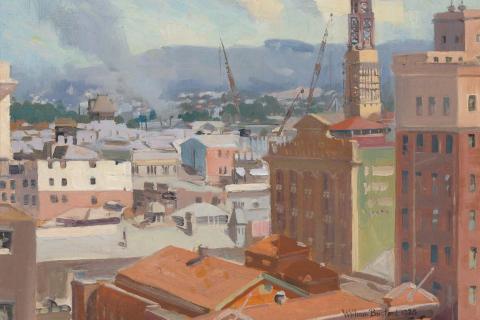Penny Sharpe: (Boats on the Brisbane River)
By Glenn R Cooke
March 2007
Penny Sharpe was encouraged in her artistic pursuits by her mother Estelle Sharpe and acknowledges especially the influence of Miss Ida Martin, the art teacher at the Ascot State School, on her primary school education. She briefly attended Fairholme College, Toowoomba and completed junior high school at Clayfield College before enrolling in the commercial art course at the Central Technical College (CTC) where she studied with Melville Haysom. When Sharpe completed the course she worked as a commercial artist on a freelance basis so was able to obtain further instruction in Haysom's Saturday morning classes where she developed a sure sense of draftsmanship. She tired of commercial art and worked as a governess for some time before she met and married David Murphy in 1963. She exhibited in the various prize competitions in Brisbane for some years: Caltex Centenary Prize (1959), Warana-Caltex Prize (1970–72), Redcliffe Art Contest (1961–64 and 1971–72) and the Royal National Association (1962–63, 1970 and 1972).
Sharpe became a member of the Glenmorgan Art Group (founded in 1970) which was one of the first groups to take advantage of the pottery courses offered through Mervyn Moriarty's Australian Flying Arts School. Sharpe potted for more than twenty years, taking instruction from tutors such as Kevin Grealy, and produced pottery influenced by Japanese aesthetics. She held several exhibitions of her work in Toowoomba. Subsequently she spun and wove the fleece of her sheep and is presently involved in cloisonné enamelling and jewellery making.
This watercolour is the product of Sharpe's studies with Melville Haysom and the subjects chosen for these classes naturally were close by the CTC grounds. (Boats on the Brisbane River) was painted from the police boat wharf between Mary Street and the Brisbane Botanic Gardens and the choice of subjects continued to chart the importance of the river to the city of Brisbane. Sharp's experimentation with watercolour washes at this time brought a new freedom into her work. Although the teaching of the CTC was shortly to be decried as being archaic and based in nineteenth-century artistic systems, Sharpe’s work of demonstrates the level of skill this training could achieve. The watercolour includes outlines in Indian ink — a favoured technique during the period, seen also in the work of Margaret Olley (see Jardin du Luxembourg, Paris 1950 and Château Fontcreuais Cassis 1951) — but Sharpe’s washes of colour are even blockier and broader. It is an accomplished production.
Connected objects
Related artists
SHARPE, Penny
1941
- present
Full profile
for SHARPE, Penny

